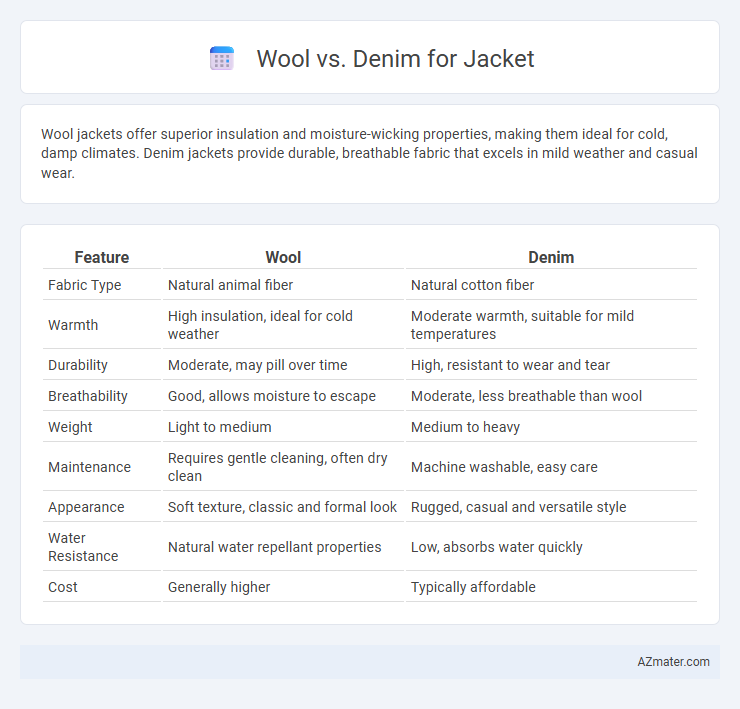Wool jackets offer superior insulation and moisture-wicking properties, making them ideal for cold, damp climates. Denim jackets provide durable, breathable fabric that excels in mild weather and casual wear.
Table of Comparison
| Feature | Wool | Denim |
|---|---|---|
| Fabric Type | Natural animal fiber | Natural cotton fiber |
| Warmth | High insulation, ideal for cold weather | Moderate warmth, suitable for mild temperatures |
| Durability | Moderate, may pill over time | High, resistant to wear and tear |
| Breathability | Good, allows moisture to escape | Moderate, less breathable than wool |
| Weight | Light to medium | Medium to heavy |
| Maintenance | Requires gentle cleaning, often dry clean | Machine washable, easy care |
| Appearance | Soft texture, classic and formal look | Rugged, casual and versatile style |
| Water Resistance | Natural water repellant properties | Low, absorbs water quickly |
| Cost | Generally higher | Typically affordable |
Introduction: Wool vs Denim Jackets
Wool jackets offer superior insulation and moisture-wicking properties, making them ideal for cold weather. Denim jackets are lightweight, durable, and provide a versatile casual style suitable for mild temperatures. Choosing between wool and denim depends on climate needs and fashion preferences.
Historical Background of Wool and Denim Jackets
Wool jackets have a historical background rooted in cold climates where natural insulation was paramount, dating back to early shepherd communities in Europe who relied on wool's warmth and durability. Denim jackets originated in the late 19th century American West as rugged workwear for miners and cowboys, with Levi Strauss pioneering durable denim fabric that resisted wear and tear. Over time, wool retained its status in formal outerwear, while denim evolved into a symbol of casual, rebellious fashion.
Material Composition: Wool and Denim Explained
Wool jackets are crafted from natural animal fibers, primarily from sheep, offering superior insulation, breathability, and moisture-wicking properties ideal for colder climates. Denim jackets consist of tightly woven cotton fibers, known for durability, rugged texture, and casual style, making them perfect for transitional weather and layering. The distinct material composition influences the jacket's warmth, weight, and care requirements, with wool providing natural temperature regulation and denim offering robust wear resistance.
Durability Comparison: Which Jacket Lasts Longer?
Wool jackets offer excellent durability due to their natural fiber strength and resistance to wear, maintaining shape and insulation over time. Denim jackets, made from sturdy cotton twill, provide high abrasion resistance and often develop a personalized patina with prolonged use. When comparing longevity, denim typically withstands rugged outdoor activities longer, while wool excels in retaining warmth and structure under varied weather conditions.
Warmth and Insulation: Wool vs Denim
Wool jackets provide superior warmth and insulation due to the natural crimp of wool fibers, which trap air and retain body heat effectively. Denim, made from cotton, offers moderate warmth but lacks the insulating properties of wool, making it less suitable for colder climates. Wool's moisture-wicking ability also helps maintain warmth by keeping the wearer dry, whereas denim absorbs moisture and loses insulating efficiency when wet.
Comfort and Fit Differences
Wool jackets offer superior insulation and natural breathability, making them ideal for colder climates while maintaining a soft, flexible fit that adapts to body movement. Denim jackets provide a stiffer, more structured fit with moderate breathability, suitable for mild weather and offering durability and casual style. Comfort in wool is enhanced by its moisture-wicking properties, whereas denim's heavier cotton fibers can feel rigid but soften over time with wear.
Style and Versatility in Outfits
Wool jackets offer a classic, refined style ideal for formal and business-casual outfits, pairing seamlessly with tailored trousers and dress shirts. Denim jackets provide a rugged, casual appeal perfect for layering with t-shirts, hoodies, and casual pants, enhancing streetwear and everyday looks. Both materials deliver versatility, with wool excelling in cooler weather and denim providing breathable comfort for transitional seasons.
Care and Maintenance Requirements
Wool jackets require gentle handling, including dry cleaning and proper storage to prevent moth damage and fabric distortion, making them ideal for colder climates with moderate maintenance needs. Denim jackets are more durable and machine washable, but frequent washing can cause fading and fabric wear, necessitating gentle cycles and cold water to preserve color and texture. Both fabrics benefit from air drying and minimal ironing to maintain their shape and longevity.
Eco-Friendliness and Sustainability
Wool jackets offer superior biodegradability and renewable sourcing since wool is a natural fiber that regenerates annually from sheep, supporting sustainable farming practices. Denim, typically made from cotton, can also be eco-friendly when produced using organic farming methods and water-efficient finishing processes but generally requires more water and pesticides. Choosing recycled or sustainably sourced wool and cotton denim enhances eco-friendliness by reducing resource consumption and textile waste in jacket production.
Final Verdict: Choosing the Right Jacket Material
Wool jackets offer superior insulation, moisture-wicking properties, and timeless elegance ideal for cold weather and formal occasions. Denim jackets provide durability, breathability, and a casual aesthetic perfect for transitional seasons and everyday wear. Selecting the right jacket material depends on climate, style preference, and intended use, with wool excelling in warmth and sophistication, while denim offers rugged versatility and comfort.

Infographic: Wool vs Denim for Jacket
 azmater.com
azmater.com